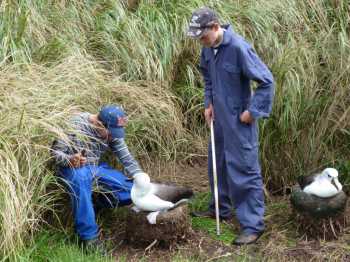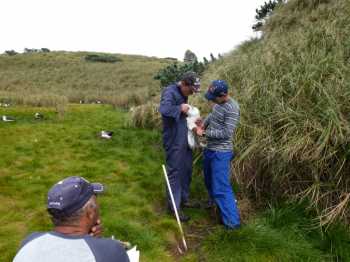The Atlantic Yellow-nosed Albatross Thalassarche chlororhynchos is endemic to the United Kingdom's Tristan da Cunha Islands in the South Atlantic where it is considered to have a conservation status of Endangered.
The species breeds on all four islands in the group with an estimated total population of 27 500 - 41 600 breeding pairs per year, equating to 55 000 - 83 200 mature individuals, although there is considerable uncertainty around the overall population estimate.
The Tristan Conservation Department (TCD) undertakes monitoring of Atlantic Yellow-nosed Albatrosses on Nightingale Island, following guidelines set out in the 2006-2010 Tristan Biodiversity Action Plan (now under revision) and the Tristan and Nightingale Islands Wildlife Monitoring Manual. Counts of breeding birds are made annually around the four molly ponds towards the island's centre with banding of adults and large chicks undertaken around the Second Pond.

Julian Repetto and George Swain check an incubating Atlantic Yellow-nosed Albatross at Second Pond, Nightingale Island
Photograph by Katrine Herian

Jerry Green, Julian Repetto and George Swain banding an Atlantic Yellow-nosed Albatross
Phootgraph by Katrine Herian
In September 2011 approximately 1000 occupied nests were counted around the four ponds at the commencement of egg laying. On 12 November 2011 when hatching had shortly commenced 784 occupied nests were counted by a team lead by the TCD's Julian Repetto. Last month 403 large chicks were counted by Julian's team, enabling a rough estimate of breeding success to be made.
Historical counts made at Nightingale's ponds suggest that the population has decreased. For example a 1972-1974 estimate of 1000-1200 pairs for the Second Pond alone can be compared with the 277 occupied nests counted in November last year.
A 2007 estimate by Peter Ryan (FitzPatrick Institute, University of Cape Town) for the whole island of 4000 pairs is given in the text of the ACAP Species Assessment. Partial counts made away from the Ponds by the TCD in 2010/11 and by Brad Robson of the Royal Society for the Protection of Birds (www.rspb.org.uk) during the 2011/12 breeding season suggest an island annual population of some 3000 to 4000 breeding pairs, giving a level of current stability.
Atlantic Yellow-nosed Albatrosses also breed on two islets adjacent to Nightingale (click here).
Although Atlantic Yellow-nosed Albatrosses have been exploited for food on Nightingale Island by the Tristan Islanders in the past, the species (including its eggs) is now fully protected throughout the whole island group by the Conservation of Native Organisms and Natural Habitats (Tristan da Cunha) Ordinance of 2006. However, it is still at risk from longline mortality at sea and so remains globally threatened.
Selected References:
Cuthbert, R., Ryan, P.G., Cooper, J. & Hilton, G. 2003. Demography and population trends of the Atlantic Yellow-nosed Albatross. The Condor 105: 439-452.
Elliott, H.F.I. 1957. A contribution to the ornithology of the Tristan da Cunha Group. Ibis 99: 545-586.
Richardson, M.E. 1984. Aspects of the ornithology of the Tristan da Cunha Group and Gough Island, 1972 - 1974. Cormorant 12: 123-201.
Tristan Island Government 2006. Tristan da Cunha Biodiversity Action Plan. 53 pp. + 10 annexes.
Rowan, M.K. 1951. The Yellow-nosed Albatross. Ostrich 22: 139-159.
Ryan, P.G., Glass, N. & Ronconi, R.A. 2011. The plants and birds of Stoltenhoff and Middle Islands, Tristan da Cunha. Polar Record 47: 86-90.
Sommer, E., Cuthbert, R. & Hilton, G. 2008. Tristan and Nightingale Islands Wildlife Monitoring Manual Research Report. RSPB Research Report 33: 1-36.
[St Helena] 2006. The Conservation of Native Organisms and Natural Habitats (Tristan da Cunha) Ordinance 2006. The St. Helena Gazette Extraordinary Vol. XLIV, No. 13.
Wace, N.M. & Holdgate, M.W. 1976. Man and Nature in the Tristan da Cunha Islands. Morges: International Union for the Conservation of Nature and Natural Resources.
With thanks to Katrine Herian (Royal Society for the Protection of Birds) and Julian Repetto (Tristan Conservation Department) for information.
John Cooper, ACAP Information Officer, 16 April 2012

 English
English  Français
Français  Español
Español